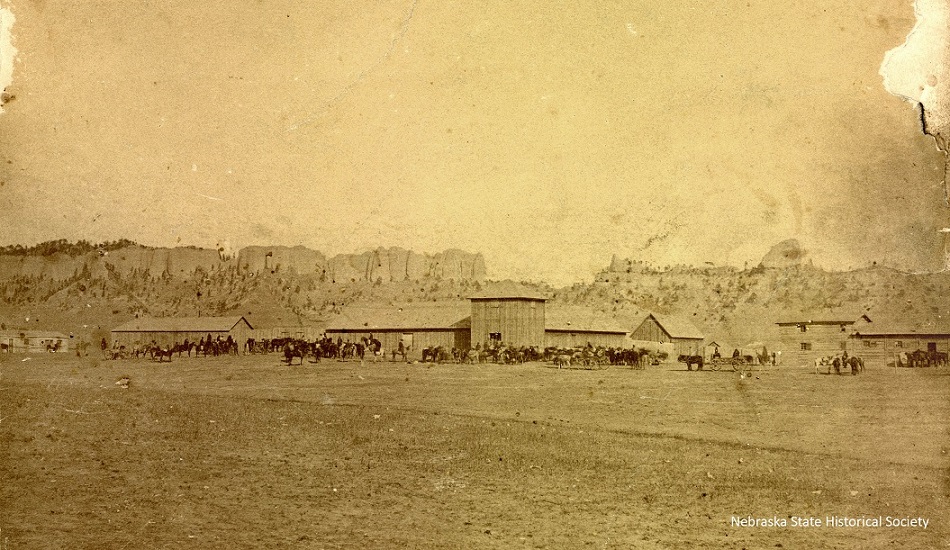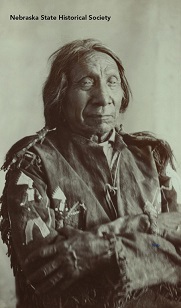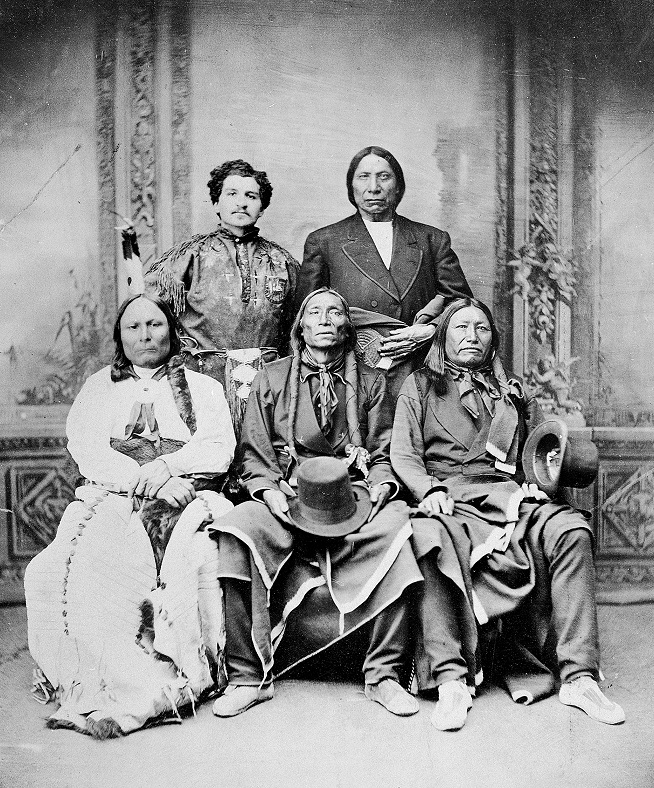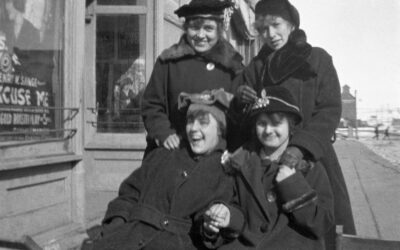
Red Cloud Agency, 1876 NSHS RG2095-80
On October 23, 1874, Lakota warriors entered Red Cloud Agency and chopped up the pole that agent John J. Saville planned to use to fly the American flag. The stage was now set for an armed confrontation, and only decisive action by Lakota leaders and U.S. troops prevented bloodshed. The incident represented the larger confrontation, conflict, and transformation brought on by gradual cultural domination of the Lakota by the whites. The story of this conflict and the events leading up to it are explored in the article “The ‘Flagpole Affair’ at Red Cloud Agency: An Incident in the Cultural Transition of the Oglala Lakota” by Randy Kane. It appears in the Fall 2016 issue of Nebraska History.
It began with the Fort Laramie Treaty of 1868. Though it removed military posts from the Bozeman Trail, it also established a reservation for the Lakota (Western Sioux) and began the process of tribal confinement. Oglala Chief Red Cloud had understood by the Treaty of 1868 that the food and supplies distribution point for his people would be at Fort Laramie, but government officials determined that too many whites lived nearby and passed through the area. An “agency” for the Oglala Lakota was established along the North Platte River thirty miles downriver from the fort. The agency at White River, known as Red Cloud Agency after the prominent Oglala Leader, became the administrative center for the Oglala to be supervised by an appointed agent representing the government.

Studio photograph of Red Cloud, taken roughly around 1900. NSHS RG1227-24-5
Agent John J. Saville arrived at Red Cloud agency in 1873. The Peace Policy authorized church denominations to appoint the agents. Saville did the bookkeeping, hired the agents, supervised the distribution of annuities and payments and acted as a liaison with the military forces in the area. In 1874, Saville attempted to erect a pole to fly the American flag over the Red Cloud Agency. Saville stated that the flag would be flown only on Sundays to let the Indians know that the agency employees did not want to be disturbed for business on that day or flown as a sign to the military camp that the agency was in trouble. The Indians, including Red Cloud, initially objected. Capt. William H. Jordan wrote that the Indians considered the erection of a flagpole as “a declaration of war against them.” Lt. Emmet Crawford responded when the Indians began chopping up the flagpole. He later testified that the agency people objected to the flagpole because “it looked too much like a military camp.”
The most prominent player in the flagpole incident, however, was the Oglala leader Sitting Bull (not to be confused with the more famous Hunkpapa Lakota leader of the same name). The Oglala Sitting Bull personified the cultural evolution of many Oglala towards acceptance of the agency and reservation way of life. Sitting Bull went on to navigate complicated and tragic relationships between Native Americans and the U.S. government. In September of 1875, Sitting Bull once again played role in quelling a disturbance created by the Lakota during negotiations at Red Cloud Agency with the government’s Allison Commission to purchase the Black Hills. In September 1876, after the summer battles at the Rosebud and the Little Bighorn, another commission led by George Manypenny came to Red Cloud Agency to dictate terms of an “agreement” forcing the Lakota to sell the Black Hills. The Indians had little choice and band leaders and headmen signed the documents.

Oglala and Brule leaders from the Nebraska agencies were photographed in Omaha on May 14, 1875, while on their way to
Washington, D.C.to meet with government officials. Sitting Bull (Oglala) is seated on the left.
Shortly after, Sitting Bull left the agency and went to the camp of Crazy Horse. Sitting Bull volunteered to join a delegation of Lakota chiefs to negotiate peace with Brig. Gen. Nelson Miles. On December 16, 1876, as the delegation approached the cantonment under the flag of truce, Crow Indian scouts serving with the army treacherously killed Sitting Bull and the other Lakota. This act infuriated Miles and ruined his attempt to negotiate surrender. Overall, many people suffered from their involvement in this fraught period in Indian-government relations. Saville was relived from office as a result of his attempt to administer cultural change. Sitting Bull was killed in his attempt to accommodate cultural change.
Read Randy Kane’s complete article (PDF).
(Former) Publications intern Brittany Hamor, UNL sophomore, wrote this blog post.
(Posted 10/14/2016; Updated 8/29/22 to clarify Sitting Bull’s identity)



